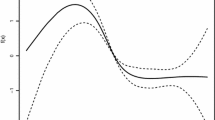Abstract
We model dynamic credit portfolio dependence by using default contagion in an intensity-based framework. Two different portfolios (with ten obligors), one in the European auto sector, the other in the European financial sector, are calibrated against their market CDS spreads and the corresponding CDS-correlations. After the calibration, which are perfect for the banking portfolio, and good for the auto case, we study several quantities of importance in active credit portfolio management. For example, implied multivariate default and survival distributions, multivariate conditional survival distributions, implied default correlations, expected default times and expected ordered default times. The default contagion is modelled by letting individual intensities jump when other defaults occur, but be constant between defaults. This model is translated into a Markov jump process, a so called multivariate phase-type distribution, which represents the default status in the credit portfolio. Matrix-analytic methods are then used to derive expressions for the quantities studied in the calibrated portfolios.
Similar content being viewed by others
References
Asmussen S. (2000) Matrix-analytic models and their analysis. Scandinavian Journal of Statistics 27: 193–226
Asmussen S. (2003) Applied probability and queues. 2nd edn. Springer, London
Assaf D., Langbert N. A., Savis T. H., Shaked M. (1984) Multivariate phase-type distributions. Operations Research 32: 688–701
Avellaneda M., Wu L. (2001) Credit contagion: Pricing cross country risk in the brady debt markets. International Journal of Theoretical and Applied Finance 4: 921–939
Bielecki, T. R., Crépey, S., Jeanblanc, M., & Rutkowski, M. (2005). Valuation of basket credit derivatives in the credit migrations enviroment. Working paper.
Bielecki T. R., Rutkowski M. (2001) Credit risk: Modeling, valuation and hedging. Springer, Berlin
Bielecki, T. R., Vidozzi, A., & Vidozzi, L. (2006). An efficent approach to valuation of credit basket products and rating triggered step-up bonds. Working paper.
Collin-Dufresne P., Goldstein R. S., Hugonnier J. (2004) A general formula for valuing defaultable securities. Econometrica 72: 1377–1407
Davis M., Esparragoza J.C. (2007) Large portfolio credit risk modelling. International Journal of Theoretical and applied Finance 10(4): 653–678
Davis M., Lo V. (2001a) Infectious defaults. Quantitative Finance 1: 382–387
Davis M., Lo V. (2001b) Modelling default correlation in bond portfolios. In: Alexander C. (eds) Mastering risk volume 2: Applications. Financial Times Prentice Hall, Englewood Cliffs, pp 141–151
Frey, R., & Backhaus, J. (2004). Portfolio credit risk models with interacting default intensities: A Markovian approach. Working paper. Department of Mathematics, University of Leipzig.
Frey, R., & Backhaus, J. (2006). Credit derivatives in models with interacting default intensities: A Markovian approach. Working paper. Department of Mathematics, University of Leipzig.
Giesecke K., Weber S. (2004) Cyclical correlation, credit contagion and portfolio losses. Journal of Banking and Finance 28: 3009–3036
Giesecke K., Weber S. (2006) Credit contagion and aggregate losses. Journal of Economic Dynamics and Control 30(5): 741–767
Gross D., Miller D. R. (1984) The randomization technique as a modelling tool and solution procedure for transient markov processes. Operations Research 32(2): 343–361
Herbertsson, A. (2005). Dynamic dependence modelling in credit risk. Licentiate thesis. Department of Mathematics, Chalmers University of Technology. Defended 2005-05-11. Opponent: Prof.Dr Rüdiger Frey, Universität Leipzig.
Herbertsson A. (2008) Pricing synthetic CDO tranches in a model with default contagion using the matrix-analytic approach. The Journal of Credit Risk 4(4): 3–35
Herbertsson A., Rootzén H. (2008) Pricing kth-to-default swaps under default contagion: The matrix-analytic approach. The Journal of Computational Finance 12(1): 49–78
Heyman D. P., Sobel M. J. (1982) Stochastic models in operations research. McGraw-Hill, New York
Jarrow R. A., Yu F. (2001) Counterparty risk and the pricing of defaultable securities. Journal of Finance 16: 1765–1800
Kraft H., Steffensen M. (2007) Bankruptcy, counterparty risk and contagion. Review of Finance 11(2): 209–252
Lando D. (2004) Credit risk modeling: Theory and applications. Princeton University Press, Princeton
McNeil A. J., Frey R., Embrechts P. (2005) Quantitative risk management. Princeton University Press, Oxford
Rogge, E., & Schönbucher, P. J. (2003). Modelling dynamic portfolio credit risk. Working paper.
Schönbucher, P. J., & Schubert, D. (2001). Copula-dependent default risk in intensity models. Working paper. Department of Statistics, Bonn University.
Sidje R. B., Stewart W. J. (1999) A numerical study of large sparse matrix exponentials arising in Markov chains. Computational Statistics and Data Analysis 29(3): 345–368
Yu F. (2007) Correlated defaults in intensity-based models. Mathematical Finance 17(2): 155–173
Author information
Authors and Affiliations
Corresponding author
Rights and permissions
About this article
Cite this article
Herbertsson, A. Modelling default contagion using multivariate phase-type distributions. Rev Deriv Res 14, 1–36 (2011). https://doi.org/10.1007/s11147-010-9052-3
Published:
Issue Date:
DOI: https://doi.org/10.1007/s11147-010-9052-3
Keywords
- Portfolio credit risk
- Intensity-based models
- Dynamic dependence modelling
- CDS-correlation
- Default contagion
- Markov jump processes
- Multivariate phase-type distributions
- Matrix-analytic methods




